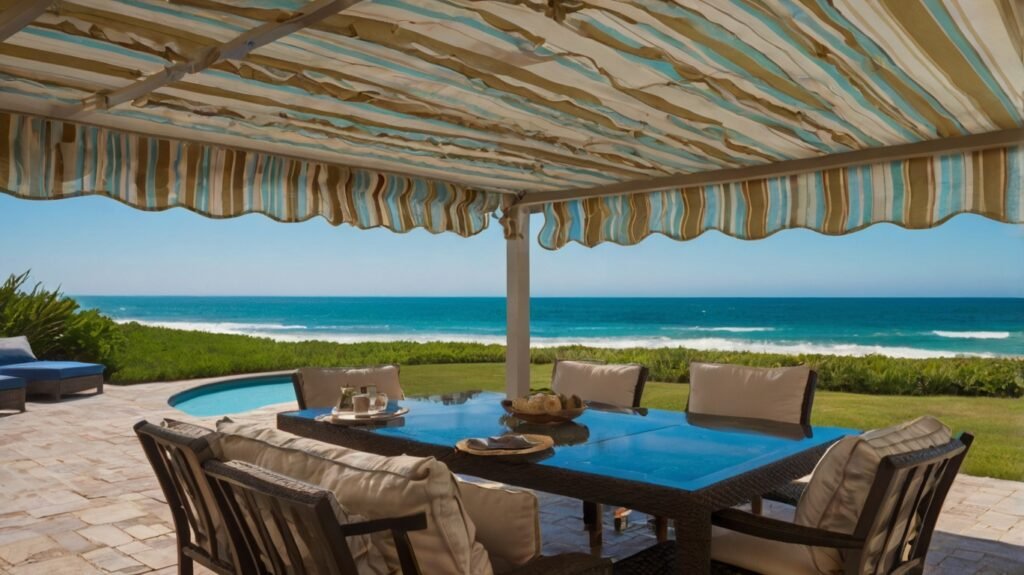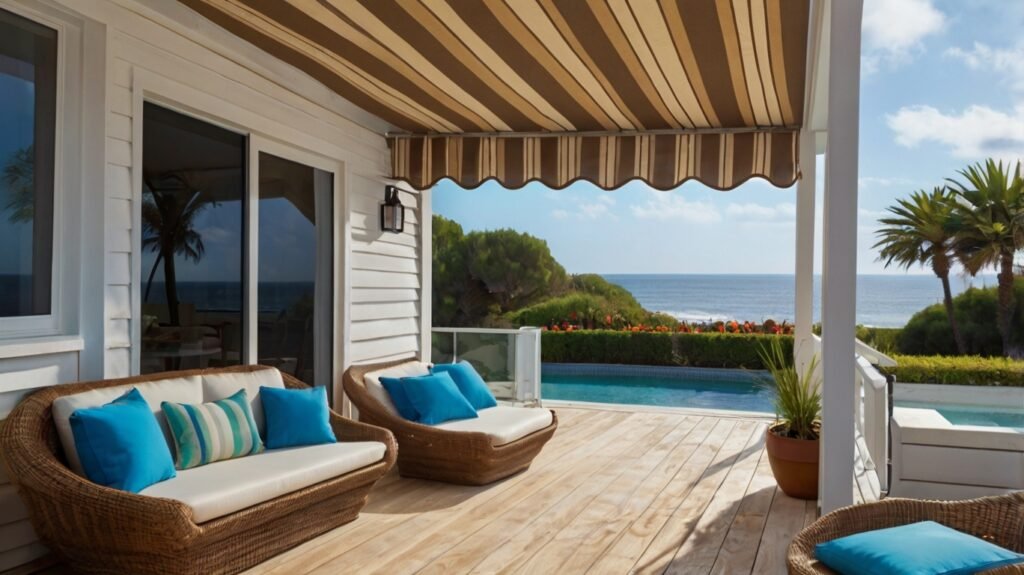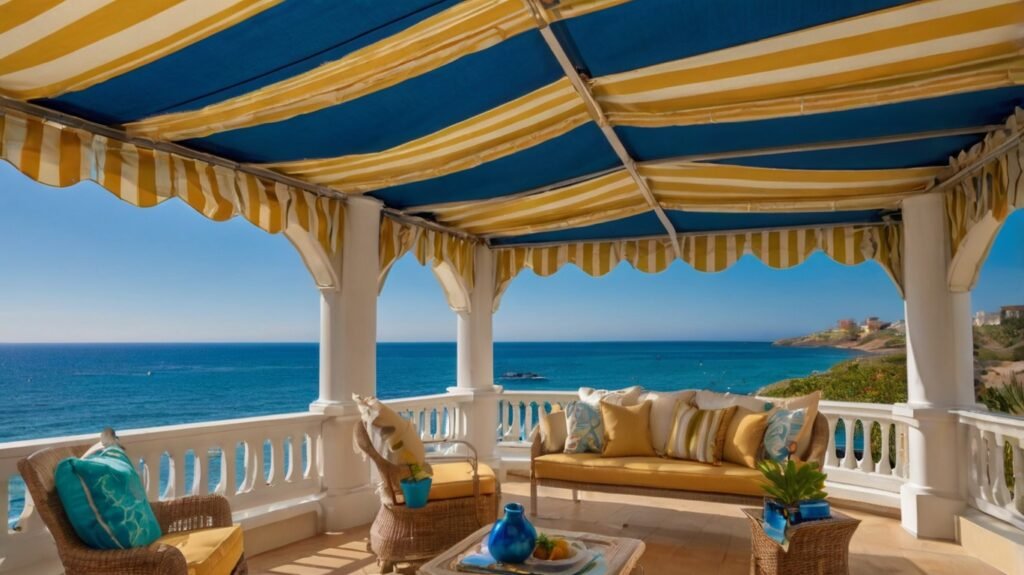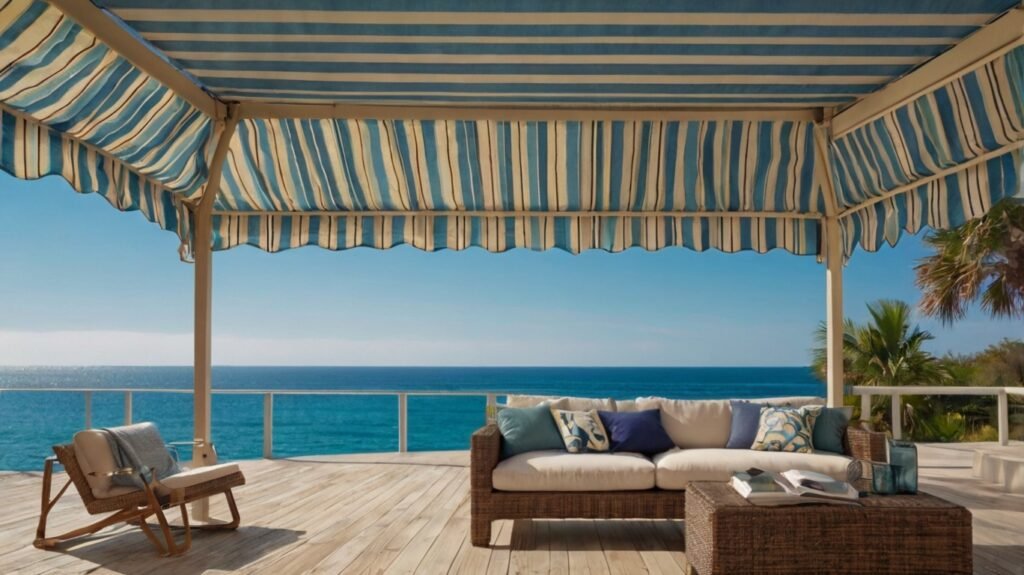The Importance of Proper Awning Fabric Selection
G’day, mate! If you’re a coastal dweller in Australia, you know that your home’s awnings cop a fair bit of punishment from the elements. The salty sea breeze, scorching sun, and unpredictable weather can wreak havoc on even the toughest materials. That’s why choosing the right fabric for your coastal awning replacement is crucial. It’s not just about aesthetics; it’s about durability, functionality, and protecting your investment.
In this comprehensive guide, we’ll dive deep into the world of awning fabrics, exploring the best options for our unique Aussie coastal conditions. Whether you’re in sunny Queensland or breezy Tasmania, I’ve got you covered. So, grab a cuppa, and let’s get stuck into it!
Understanding Coastal Climate Challenges
Before we jump into fabric choices, let’s take a moment to appreciate the unique challenges our coastal climate presents. It’s like Mother Nature’s having a constant barbie, and your awnings are on the grill!

The Salty Situation
Living by the sea is a dream for many, but it’s a nightmare for fabrics. Salt air is notoriously corrosive, eating away at materials like a koala through a gum leaf. As coastal expert Dr. Sarah Thompson puts it, “Salt crystallization on fabrics can lead to rapid degradation, especially in areas with high humidity.”
UV Radiation: The Silent Destroyer
We Aussies love our sunshine, but so does UV radiation. It’s like an uninvited guest at a beach party, causing fabrics to fade, weaken, and deteriorate over time. In coastal areas, this effect is amplified due to reflection from the water and sand.
Wind and Rain: The Dynamic Duo
Coastal areas are prone to strong winds and sudden downpours. Your awning fabric needs to stand up to these forces without tearing, sagging, or allowing water to pool. It’s a tall order, but the right fabric can handle it with ease.
Top Fabric Options for Coastal Awnings
Now that we’ve set the scene, let’s explore some of the best fabric options for your coastal awning replacement. These materials have proven their mettle against the harsh Aussie coastal conditions.
Acrylic Fabrics: The All-Rounder
Acrylic fabrics, like Sunbrella, have become a go-to choice for coastal awnings. They’re like the Swiss Army knife of awning materials – versatile, reliable, and up for any challenge.
Pros:
- Excellent UV resistance
- Water-repellent
- Mildew resistant
- Wide range of colours and patterns
Cons:
- Can be more expensive than some alternatives
- May require special cleaning techniques
Solution-Dyed Polyester: The Tough Cookie
If acrylic is the Swiss Army knife, solution-dyed polyester is the Crocodile Dundee knife of awning fabrics. It’s tough, no-nonsense, and ready for action.
Pros:
- Highly durable
- Excellent colour fastness
- Good resistance to stretching and sagging
- Often more affordable than acrylic
Cons:
- May not be as soft or aesthetically pleasing as acrylic
- Can be prone to mildew if not properly maintained
Vinyl-Coated Polyester: The Waterproof Wonder
For those areas where rain is as common as a kangaroo in the outback, vinyl-coated polyester might be your best bet. It’s like giving your awning a raincoat!
Pros:
- Extremely waterproof
- Easy to clean
- Resistant to mildew and UV rays
Cons:
- Limited colour options
- Can feel less breathable than other fabrics
Olefin: The Eco-Friendly Option
If you’re keen on doing your bit for the environment, olefin fabric might tickle your fancy. It’s recyclable and requires less energy to produce than some other options.
Pros:
- Environmentally friendly
- Good UV resistance
- Affordable
Cons:
- Not as durable as acrylic or polyester
- Can be prone to stretching over time

Key Factors to Consider When Choosing Awning Fabric
Choosing the right fabric for your coastal awning is like picking the perfect surfboard – it needs to suit your specific conditions and preferences. Here are some key factors to keep in mind:
Durability: Built to Last
In the coastal environment, durability is king. Look for fabrics with high tensile strength and tear resistance. As awning expert John Davis notes, “A fabric’s ability to withstand constant exposure to salt, sun, and wind is crucial for longevity in coastal areas.”
Water Resistance: Keeping Things Dry
While no fabric is completely waterproof (unless it’s coated), good water resistance is essential. You want a fabric that will shed water quickly and dry fast to prevent mould and mildew growth.
UV Resistance: Shading with Confidence
UV resistance isn’t just about preventing fabric degradation; it’s also about protecting you and your outdoor space from harmful rays. Look for fabrics with high UPF (Ultraviolet Protection Factor) ratings.
Breathability: Letting Your Awning Breathe
A breathable fabric allows air to circulate, reducing heat build-up and preventing that stuffy feeling under your awning. It’s like giving your outdoor space a good set of lungs!
Ease of Maintenance: Keeping It Clean
Let’s face it, none of us want to spend our weekends scrubbing awnings. Choose a fabric that’s easy to clean and maintain. Some fabrics even come with special treatments that repel dirt and stains.

Colour Selection and Its Impact
Choosing the right colour for your coastal awning isn’t just about aesthetics – it can significantly impact its performance and longevity. Let’s paint a picture of why colour matters:
Light vs. Dark Colours
Light colours reflect more sunlight, keeping the area underneath cooler. Dark colours absorb more heat but can be more effective at blocking UV rays. It’s a bit of a balancing act, like choosing between a day at Bondi or a bushwalk in the Blue Mountains.
Fading Considerations
Coastal sunlight is relentless, and some colours fade faster than others. Generally, reds and blues are more prone to fading, while neutrals and earth tones tend to hold their colour better.
Complementing Your Home’s Exterior
While performance is crucial, you also want your awning to look ripper! Choose a colour that complements your home’s exterior and fits with the coastal vibe. As interior designer Emma White suggests, “Consider the overall palette of your outdoor space, including your home’s exterior, landscaping, and outdoor furniture.”
Maintenance and Care Tips for Coastal Awnings
Proper maintenance can extend the life of your coastal awning fabric significantly. Here are some tips to keep your awning looking schmick:
Regular Cleaning
Give your awning a gentle clean every few months. Use a soft brush and mild soap solution to remove salt deposits, bird droppings, and general grime. It’s like giving your awning a day at the spa!
Prompt Stain Removal
Deal with stains as soon as they happen. Most awning fabrics have stain-resistant treatments, but prompt action can prevent permanent marks.
Reapplying Water Repellent
Over time, the water-repellent finish on your awning may wear off. Reapply a fabric guard every couple of years to maintain its water resistance.
Proper Storage
If you live in an area prone to cyclones or severe storms, consider retracting or removing your awning during these events. It’s better to be safe than sorry!
Cost Considerations and Long-Term Value
Investing in quality awning fabric might seem like a bit of a splurge upfront, but it’s worth considering the long-term value. As the old saying goes, “Buy cheap, buy twice.”
Initial Cost vs. Longevity
Higher-quality fabrics like acrylic and solution-dyed polyester may cost more initially, but their durability can save you money in the long run. It’s like choosing between a cheap pair of thongs that’ll last a summer, or a quality pair that’ll see you through years of beach trips.
Energy Savings
A well-chosen awning can significantly reduce your cooling costs by shading windows and outdoor areas. According to energy efficiency expert Dr. Lisa Chen, “Properly installed awnings can reduce heat gain by up to 77% on west-facing windows and 65% on south-facing windows.”
Warranty Considerations
Many high-quality awning fabrics come with warranties ranging from 5 to 10 years. While it might not be as exciting as a warranty on a new barbie, it’s certainly worth considering when making your choice.
Professional Installation vs. DIY
Once you’ve chosen your fabric, the next question is: should you install it yourself or call in the pros? Let’s weigh up the options:
DIY Installation
If you’re handy with tools and have some experience, DIY installation can save you some dough. However, it’s crucial to be honest about your skills – a poorly installed awning is about as useful as a screen door on a submarine.
Pros:
- Cost savings
- Sense of accomplishment
- Flexibility in timing
Cons:
- Risk of improper installation
- Time-consuming
- May void warranty if not done correctly
Professional Installation
For most of us, professional installation is the way to go. It’s like calling in a skilled tradie – they’ve got the tools, the know-how, and the experience to get the job done right.
Pros:
- Expertise and experience
- Proper tools and equipment
- Often includes warranty on workmanship
- Time-saving
Cons:
- Higher upfront cost
- Dependent on installer’s schedule
Environmental Impact and Sustainability
In today’s world, it’s important to consider the environmental impact of our choices. When it comes to awning fabrics, there are a few things to keep in mind:
Recyclability
Some fabrics, like olefin, are fully recyclable at the end of their life. Others may have recycling programs through the manufacturer. It’s worth looking into these options to reduce landfill waste.
Production Process
Consider the energy and resources used in producing the fabric. Solution-dyed fabrics, for example, use less water in their production process compared to piece-dyed fabrics.
Longevity
A durable fabric that lasts longer is generally better for the environment than one that needs frequent replacement. As environmental scientist Dr. Tom Roberts puts it, “The most sustainable product is often the one you don’t have to buy again.”
Local Production
If possible, choose fabrics produced locally to reduce transportation emissions. Supporting local Aussie businesses is a win-win!
Conclusion
Choosing the best fabric for your coastal awning replacement doesn’t have to be a headache. By considering factors like durability, water resistance, UV protection, and colour, you can find a fabric that not only looks great but also stands up to the harsh coastal conditions.
Remember, your awning is an investment in your home’s comfort and value. Taking the time to choose the right fabric can save you money and hassle in the long run. Whether you opt for the versatility of acrylic, the toughness of solution-dyed polyester, or the eco-friendliness of olefin, there’s a perfect fabric out there for your coastal home.
So, next time you’re relaxing under your new awning, cold bevvy in hand, watching the waves roll in, you can pat yourself on the back for making a choice that’ll keep you comfortable for years to come. After all, that’s what the Aussie coastal lifestyle is all about – enjoying the beauty of our shores without worrying about the little things.
Now, go forth and choose that perfect awning fabric. Your future self (and your home) will thank you!
FAQs
- How often should I replace my coastal awning fabric?
With proper care, a high-quality awning fabric can last 7-10 years. However, in harsh coastal environments, you might need to replace it sooner. - Can I use regular fabric for my coastal awning?
It’s not recommended. Regular fabrics aren’t designed to withstand the harsh coastal conditions and will deteriorate quickly. - Are there any fabrics that are completely resistant to salt damage?
While no fabric is completely immune to salt damage, solution-dyed acrylic and polyester fabrics offer excellent resistance. - How do I clean salt deposits off my awning?
Regularly rinse your awning with fresh water to prevent salt buildup. For tougher deposits, use a soft brush and mild soap solution. - Can awning fabric help reduce my energy bills?
Yes! A well-chosen awning can significantly reduce heat gain in your home, potentially lowering your cooling costs. - Is it worth paying extra for a branded fabric like Sunbrella?
Often, yes. Branded fabrics usually offer superior quality, better warranties, and proven performance in coastal conditions. - Can I paint my existing awning fabric to change its colour?
It’s not recommended. Painting can affect the fabric’s breathability and water resistance. It’s better to replace the fabric if you want a colour change. - How do I know if my awning fabric is UV resistant?
Look for fabrics with a high UPF (Ultraviolet Protection Factor) rating. Most quality awning fabrics will specify their UV resistance. - Are there any eco-friendly options for coastal awning fabrics?
Yes, fabrics like olefin are recyclable and require less energy to produce. Some manufacturers also offer recycling programs for their fabrics. - Can I install coastal awning fabric myself?
While it’s possible, professional installation is recommended for best results and to ensure warranty coverage.

